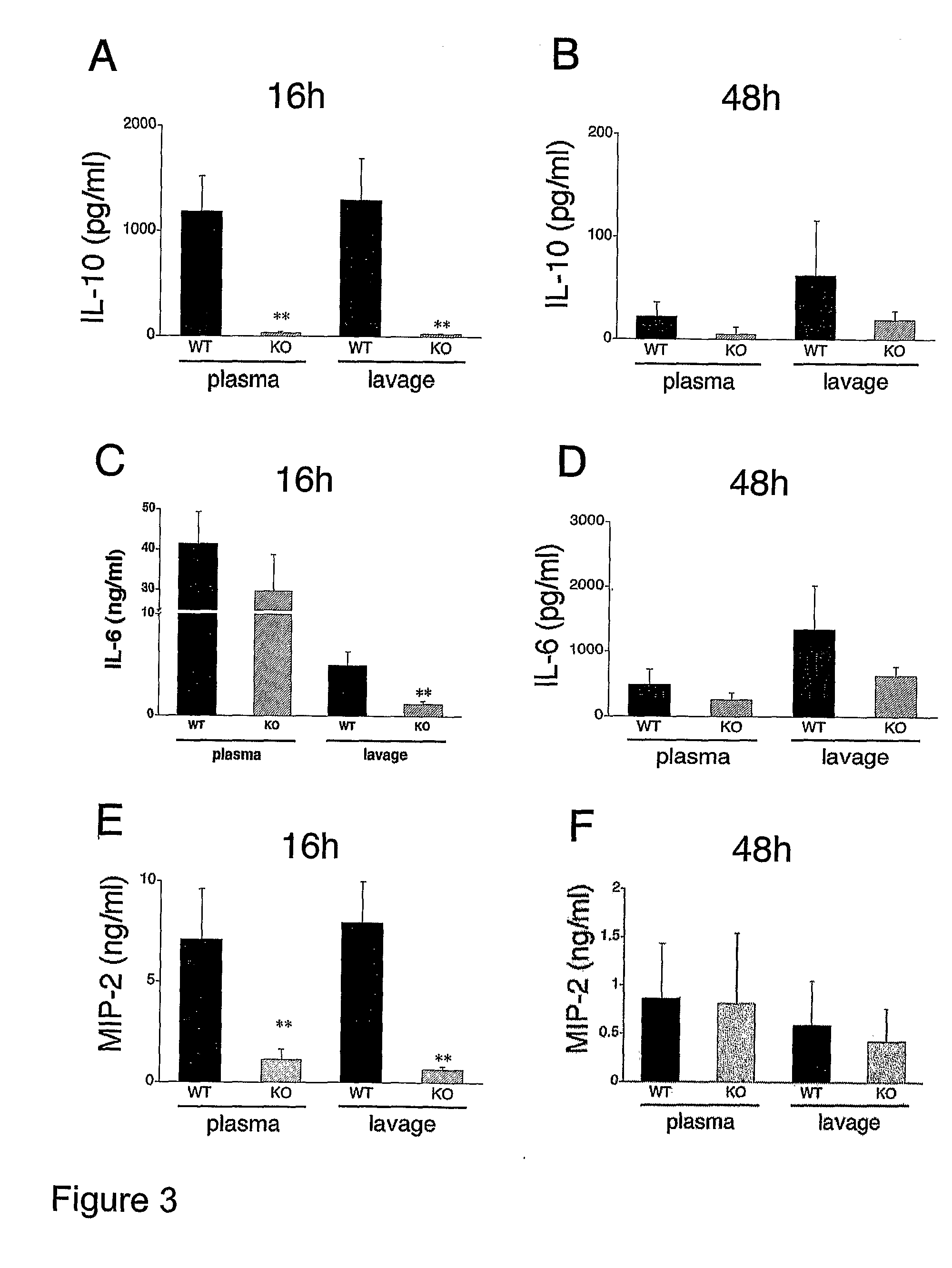Sepsis Prevention Through Adenosine Receptor Modulation
a technology of adenosine receptor and sepsis, which is applied in the direction of antibody medical ingredients, peptide/protein ingredients, biocide, etc., can solve the problems of limited therapeutic options for improving the outcome of patients with sepsis, human beings that relied on, and conducted using inadequate models, so as to prevent organ dysfunction in murine septic shock and reduce mortality
- Summary
- Abstract
- Description
- Claims
- Application Information
AI Technical Summary
Benefits of technology
Problems solved by technology
Method used
Image
Examples
example 1
Genetic A2a Receptor Deficiency Protects Against CLP-Induced Mortality
[0079]Control (WT) mice had a mortality rate of approximately 70% when recorded on day 5 after the CLP procedure (FIG. 1). This mortality rate was the result of a gradual process, which was characterized by 10-20% of the mice dying every day. No changes in mortality were detected when the mice were followed for an additional 5 days (data not shown). The mortality rate of A2a KO mice was significantly lower on each day with a ˜35% mortality rate on day 5 after CLP (FIG. 1). There were no additional deaths in this group until the termination of the experiment (10 days after the surgery, data not shown).
example 2
A2a Receptor Deficiency Improves Bacterial Clearance
[0080]Because persistence of local bacterial infection and bloodstream invasion play important roles in mortality in the CLP model, we next assessed the impact of A2a receptor inactivation on bacterial levels at the primary peritoneal site of infection and in the blood stream. We found markedly decreased numbers of bacteria in both the blood and peritoneal lavage fluid of A2a receptor KO mice when compared to WT animals at 16 hours (FIGS. 2A and 2B). Bacterial numbers fell substantially by 48 hours after surgery in both the blood and peritoneal lavage fluid and there were no differences in CFUs between A2a KO and WT mice at this point (FIGS. 2C and 2D). Blood and peritoneal lavage fluid remained sterile in sham-operated A2A receptor KO and WT mice (data not shown).
example 3
Effect of Genetic A2a Receptor Inactivation on Cytokine Production and Markers of Organ Injury
[0081]Because IL-10 appears to be an essential mediator in sepsis-induced impairment in antibacterial host defense, we compared IL-10 concentrations in the plasma and peritoneal lavage fluid obtained from A2a receptor KO and WT mice subjected to CLP or sham-operation. Sham-operated A2a receptor WT or KO mice had no detectable levels of IL-10 in their plasma or peritoneal lavage fluid (data not shown). While CLP elevated IL-10 concentrations in both the plasma and peritoneal lavage fluid in both A2a receptor KO and WT mice, A2a KO mice exhibited markedly lower levels of IL-10 at 16 hours after the CLP procedure (FIG. 3A). IL-10 concentrations subsided to comparable levels in septic A2a KO and WT mice by 48 hours (FIG. 3B).
[0082]Because IL-6 blockade with neutralizing antibodies has been shown to be protective in CLP-induced sepsis, we next explored the role of A2a receptors in regulating IL-...
PUM
| Property | Measurement | Unit |
|---|---|---|
| thick | aaaaa | aaaaa |
| time | aaaaa | aaaaa |
| ligand affinity | aaaaa | aaaaa |
Abstract
Description
Claims
Application Information
 Login to View More
Login to View More - R&D
- Intellectual Property
- Life Sciences
- Materials
- Tech Scout
- Unparalleled Data Quality
- Higher Quality Content
- 60% Fewer Hallucinations
Browse by: Latest US Patents, China's latest patents, Technical Efficacy Thesaurus, Application Domain, Technology Topic, Popular Technical Reports.
© 2025 PatSnap. All rights reserved.Legal|Privacy policy|Modern Slavery Act Transparency Statement|Sitemap|About US| Contact US: help@patsnap.com



